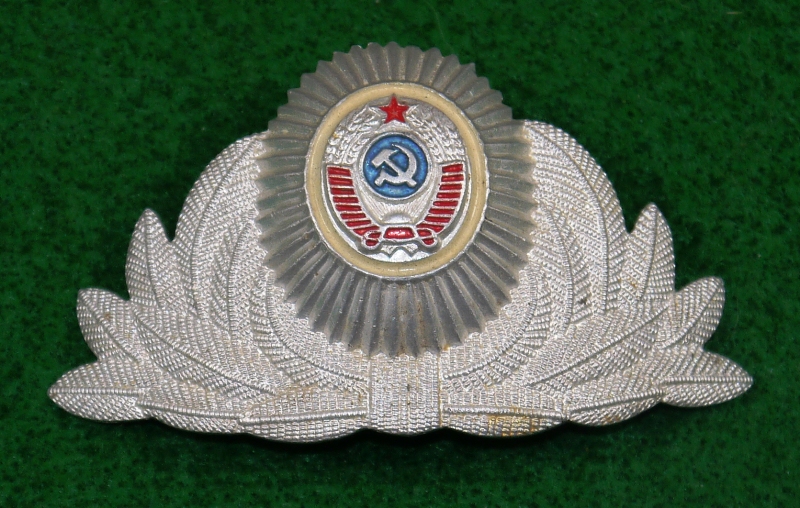 Caps of the Soviet Police (Militia)
Caps of the Soviet Police (Militia)Despite its rather militaristic name, the Soviet Militia was a police organization, with all of the same duties of police departments in the West as well as a few unique to a totalitarian regime. These included enforcing the criminal laws of the USSR; fighting corruption, traffic control, and maintaining public order. They also maintained the internal passport system, authorized residency and maintained surveillance over citizens. The Militia was subordinated to the NKVD or MVD (depending on the time period), which has caused no end of confusion to novice collectors and historians. However, the Militia was a separate administration within the NKVD/MVD, not part of the more notorious State Security organs or Internal Troops. For most of the Cold War period, Militia forces were actually subordinated to the various republics making up the USSR, but uniforms were the same for all police regardless of location. The most significant changes to police uniforms occured in 1969 when dark gray replaced dark blue as the main fabric color, although you will see a number of lesser changes in color and style prior to that date on the caps described below.
In terms of availability, while the later gray caps are still fairly easy to acquire, blue caps are surprisingly hard to find outside the Former USSR. A thumbnail image accompanies each cap description. Clicking on that thumbnail will bring up a larger, higher resolution image.
| Every now and then I make a mistake and the first entry I previously had shown on this page - of the M43 militiaman's cap with azure band and piping shown here - was, in fact, a replica and not a very good one at that! The presence of light blue piping on these early police caps has now been discredited, with Russian experts (such as shown on the excellent site: Uniforms and Insignia of the Police February 1943 - January 1958) verifying police piping was red for all police from 1940 on! The source of this confusion was "probably" due to mistakes in the otherwise widely-respected 1995 "History of Russian Uniform - Soviet Police 1918-1991" book. I will be adding a description of a correct cap from this period in the near future. Please excuse any confusion this has caused. | 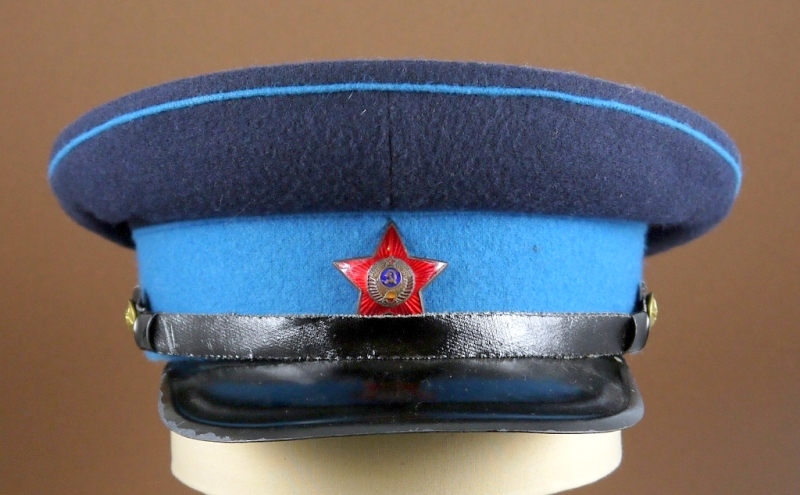
|
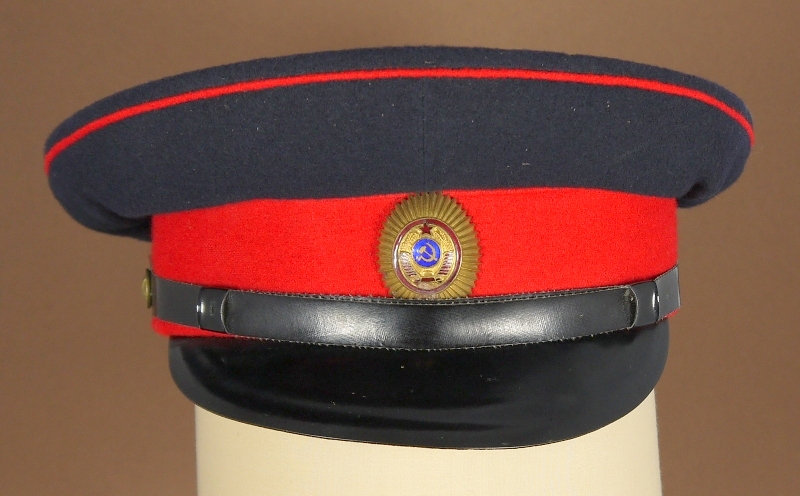
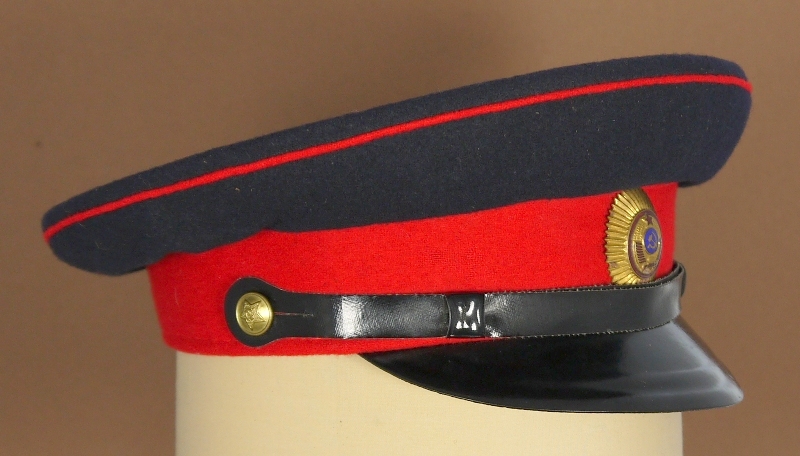 Militia
Militia
Officer Parade/Service
1958-1964
UNDER REVISION
In 1947, the Soviet Militia changed their uniform colors to dark blue with red as the secondary color but cockades were again changed in 1958.
This 1962-dated cap has a dark blue napped wool crown with red wool band and piping. All personnel below the rank of Commissioner wore the black oilcloth chinstrap and gilt metal buttons shown here during this period. The visor is black-lacquered fiberboard of semi-circular shape.
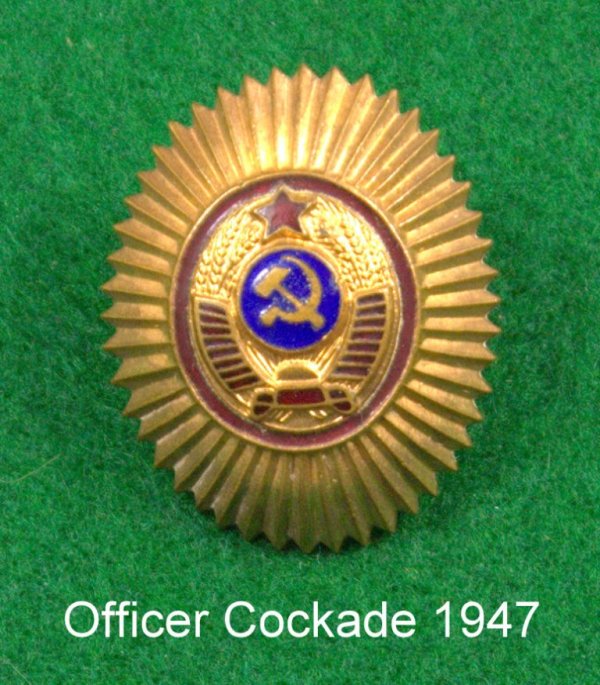
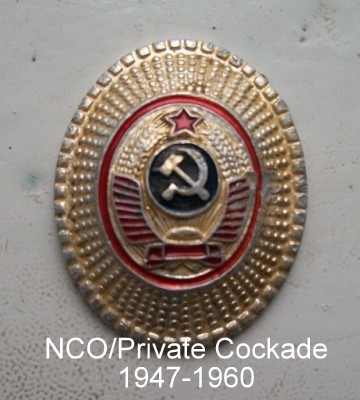
The cockade is what identifies this as an officer's cap - vice that worn by Militiamen and Sergeants. From 1947 to 1961 only officers used a fluted-edge oval cockade - with lesser ranks using a different one with pebbled edges. You can see these two types to the left.
In 1961 - this officer-style cockade became standard for all personnel. A close look at the particular cockade on this cap identifies it as an early tombac (brass and copper alloy) version with hot (glass) enameling. In 1961 aluminum cockades became the norm with cold enamel (paint) decoration.
Scarce
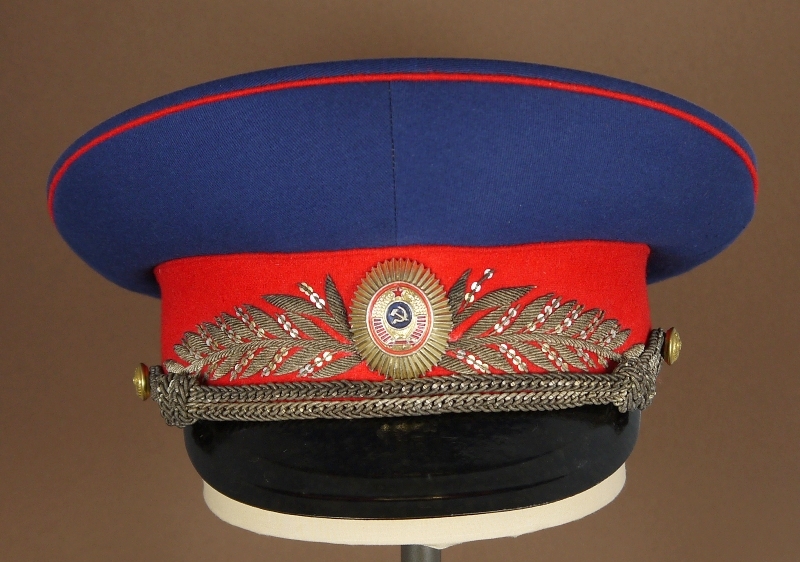
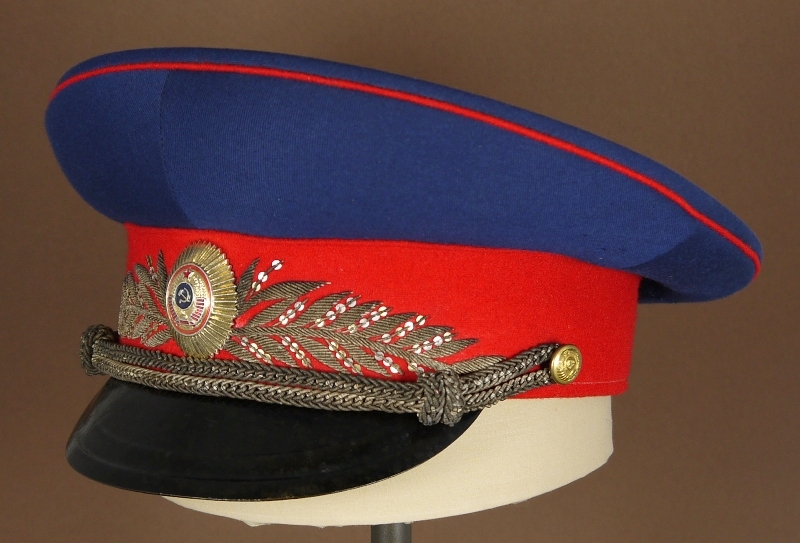 Militia
Militia
Commissioner Parade
????
UNDER REVISION This cap illustrates a parade-walking out cap worn by a Commissioner (a rank re-titled "General" in 1973) during the first 10 years of the blue and red police uniform. The crown is blended dark blue wool and both band and piping are in plain red wool. Like the other caps of this period, the crown is relatively smaller in circumference and lower in height than later caps. The inside has typical general-officer upgrades: silk lining, real leather sweatband and a leather label indicating manufacture by the famous Ц.Э.П. КОМБИНАТ УВС МО МОСКВА (Central Experimental Manufacturing Plant, Clothing supply management of the Ministry of Defense, Moscow). Multi-piece all-brass buttons embossed with the Great Seal of the USSR support silver filigreed cords (here heavily tarnished) above the black enameled fiberboard visor. A standard fluted-edge gilt Militia cockade is pinned through the band and is surrounded by sprays of laurel leaves embroidered in silver wire.
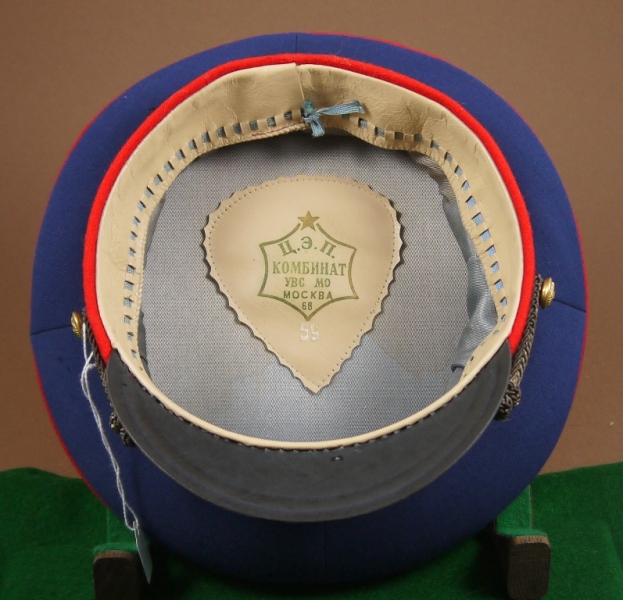 If I stopped here and did not show you a picture of the inside of this cap - all would be simple and clear. Unfortunately, while the embroidery and other elements of this cap are absolutely correct for a Commissioner's parade cap during the period 1947-1957; you can see my cap is stamped 1968!
And by 1968, the rules for Commissioners' cap ornamentation had changed. Their everyday cap had no embroidery at all (just silver cords) while the parade cap had silver laurel leaf embroidery on both the band AND the visor (as well as a silver-embroidered leather chinstrap).
Since there was no "collector" market in those days, I believe this cap was produced as a display or museum piece to illustrate the older 1947-1956 version. I would welcome any other ideas that might explain the date anomaly.
In any case, this is a lovely cap and like all Militia Commissioner items made before 1969 is quite rare.
Rare-Very Rare
If I stopped here and did not show you a picture of the inside of this cap - all would be simple and clear. Unfortunately, while the embroidery and other elements of this cap are absolutely correct for a Commissioner's parade cap during the period 1947-1957; you can see my cap is stamped 1968!
And by 1968, the rules for Commissioners' cap ornamentation had changed. Their everyday cap had no embroidery at all (just silver cords) while the parade cap had silver laurel leaf embroidery on both the band AND the visor (as well as a silver-embroidered leather chinstrap).
Since there was no "collector" market in those days, I believe this cap was produced as a display or museum piece to illustrate the older 1947-1956 version. I would welcome any other ideas that might explain the date anomaly.
In any case, this is a lovely cap and like all Militia Commissioner items made before 1969 is quite rare.
Rare-Very Rare
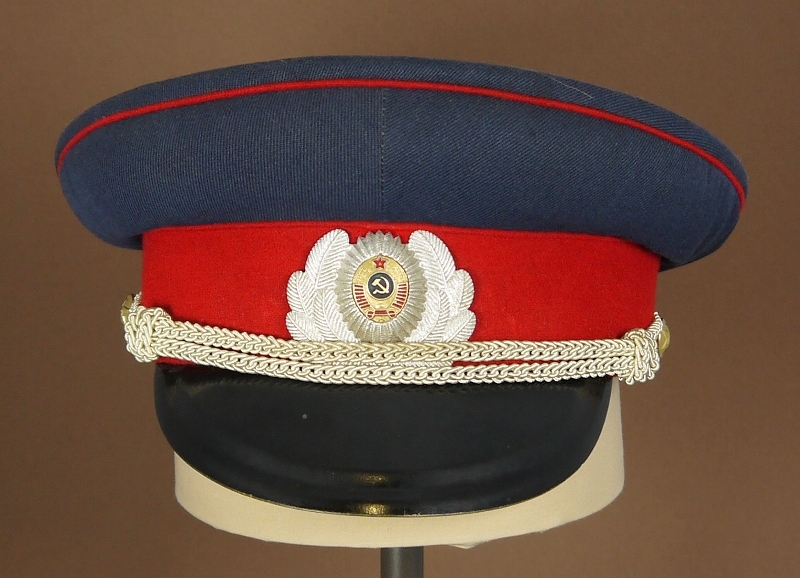
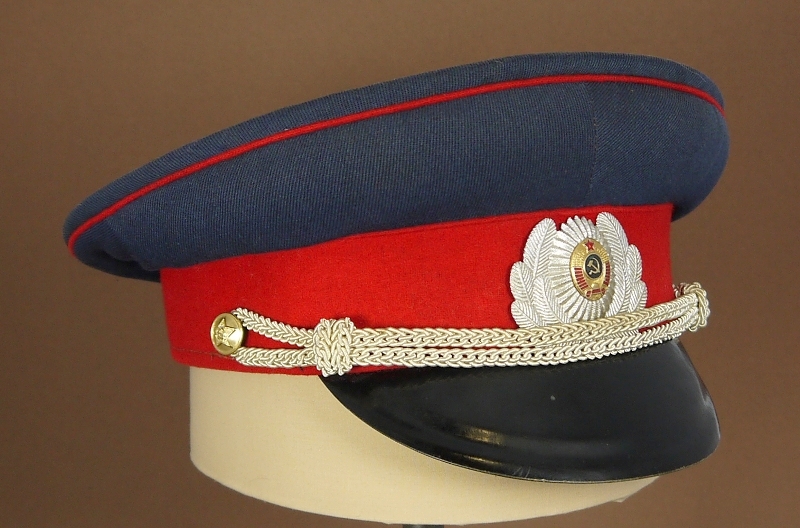 Militia
Militia
Officer/Militiaman Parade/Walking Out
1965-1969
Relatively short lived, this cap made up part of the new parade/walking out dress uniform introduced in 1965 for colonels and below. It remained in use only until the
new gray Militia uniform was introduced in 1969. This 1968-dated cap has the small dark blue blended wool crown common to the late 1960s with red band and piping.
The visor is fiberboard and the buttons are 2-piece brass and steel.
However, the key distinguishing features of this cap are the silver cockade and cords. Now authorized for wear by all ranks on their parade caps, silver filigree cords were once
the sole perview of Commissioners. The M1965 cockade with its silver wreath and gilt center was new and only authorized for parade wear.
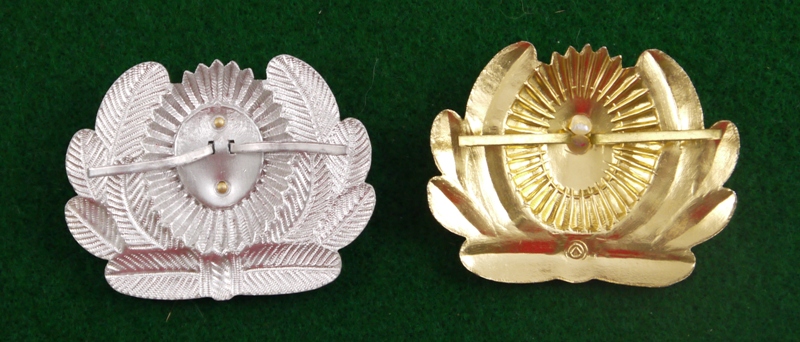
I've provided a picture of the back of
this cockade alongside that of the later all-gilt M1977 of the same shape. You can see the silver M1965 was made in two pieces, with the gilt center attached to the silver wreath with pins. Be careful of this distinction: as I discuss later on this page - all-silver M1965-type police cockades are replicas. The center must be gilt to be authentic.
Rare
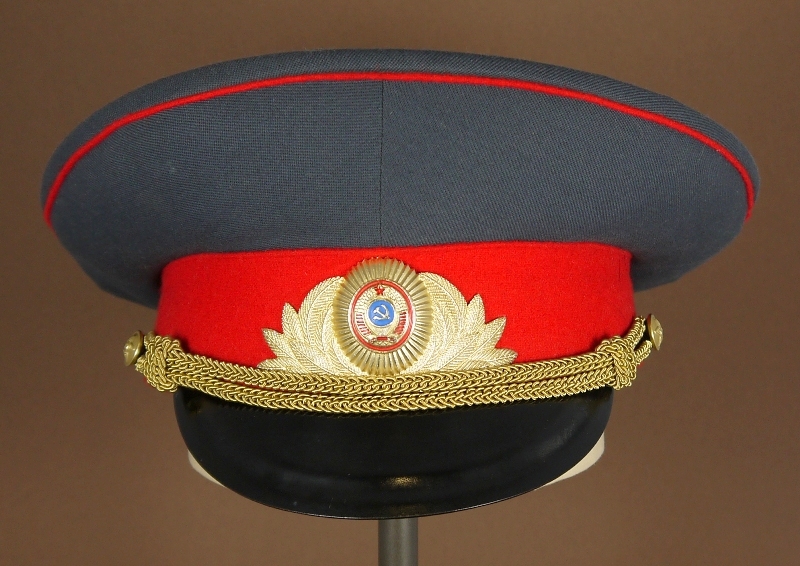
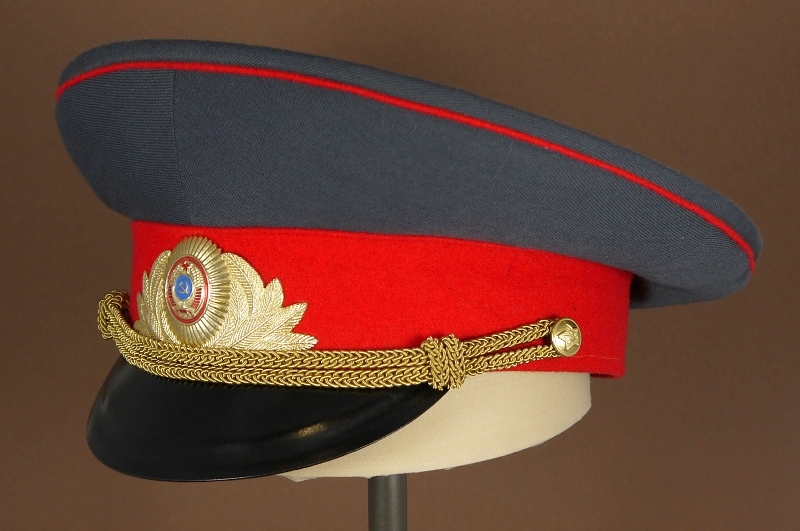 Militia
Militia
Officer/Militiaman Service/Parade
1969-1976
In 1969 the Soviet Militia published regulations in which the blue and red uniform was replaced with dark gray and red. This 1976-dated cap represents the first model officer/Militiaman cap for this new uniform. As with M69-style caps of the Soviet military, the crown of this cap displays the larger circumference and higher height of this model. The crown is made of blended, diagonal patterned wool instead of the napped wool so common in the 40's, 50's and early 1960's. Gilt filigree cords were now standard for all Militia caps, regardless of the wearer's rank or uniform style. The visor is black lacquered fiberboard - also standard (but not exclusive) until the mid-1980's. The cockade is similar to those worn on army parade caps of the period - consisting of a rather large wreath of 18 laurel leaves with a center oval mirroring the earlier fluted-edge Militia cockade. In fact, although the cockade on this cap is one-piece cast anodized aluminum, when first introduced this cockade came in two-pieces consisting of a new stamped brass wreath through which an old oval cockade was pinned. The M69 Militia cockade remained in use until 1977 when a smaller emblem was authorized.
Officers below the rank of Colonel wore this emblem on both service and parade uniforms. However, Commissioners and Colonels of Militia continued to use aluminum versions of the M47 oval cockade without a wreath.
Available
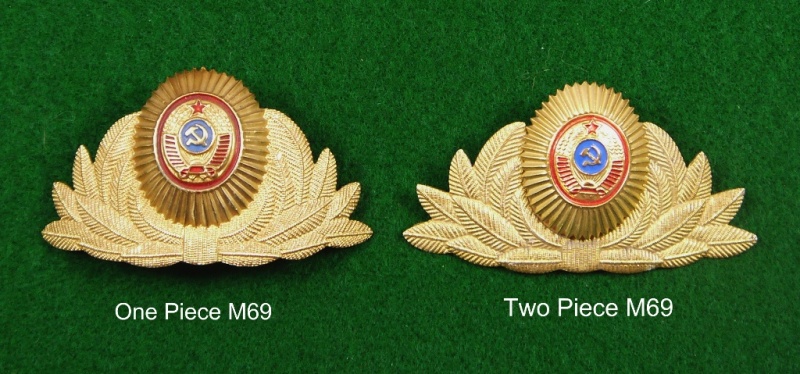
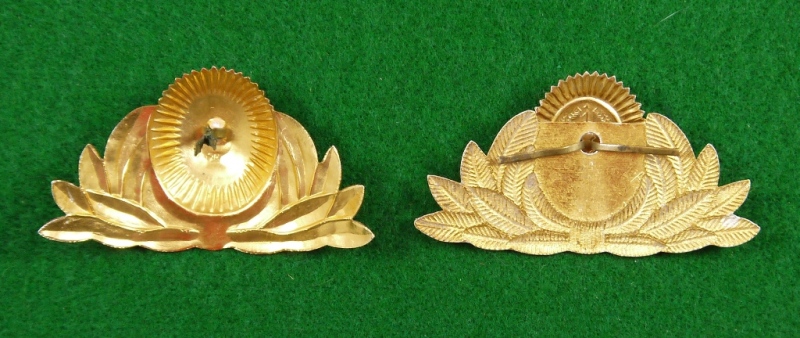
|
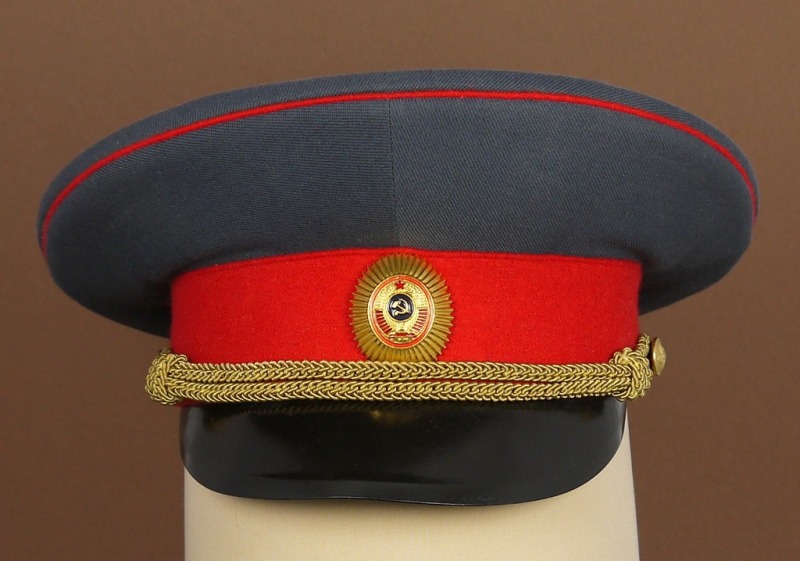
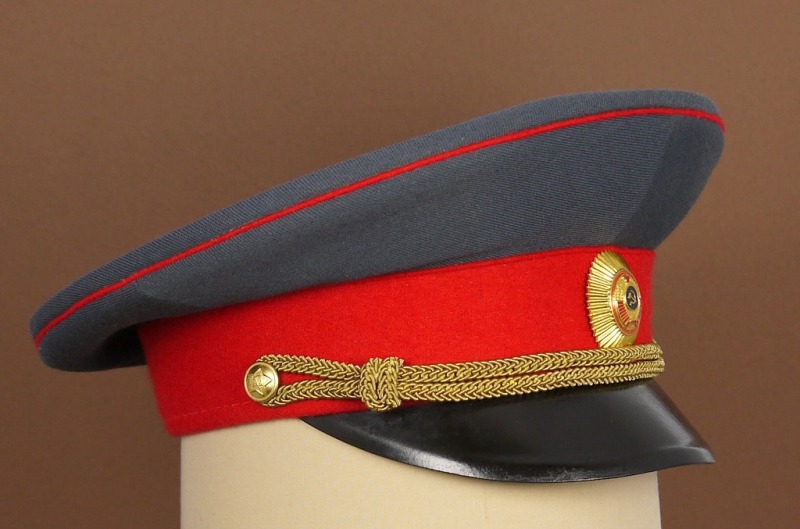 Militia
Militia
Colonel Service/Parade
1969-1991
An unusual feature of Militia uniform regulations was the fact that Colonels (Polkovniki) wore a less decorative cap than their subordinates. Shown here is such a cap - worn for both winter service and for dress parade.
The only difference from the Militiaman's cap just described is the use of a simple oval cockade vice the wreathed ones authorized in 1969 and again in 1977.
This in fact, was the distinguishing characteristic of a Colonel's cap. While some Russian collectors believe Colonels wore heavier tombac versions of this
cockade as late as 1991 - there is no real evidence to support this assertion. They appeared to transition to the lighter aluminum version along with the rest of the Militia.
The other elements of this 1978-dated cap are standard for the time - dark gray top, red band, black fiberboard visor, gold filigree cords and two-piece stamped metal buttons.
Available
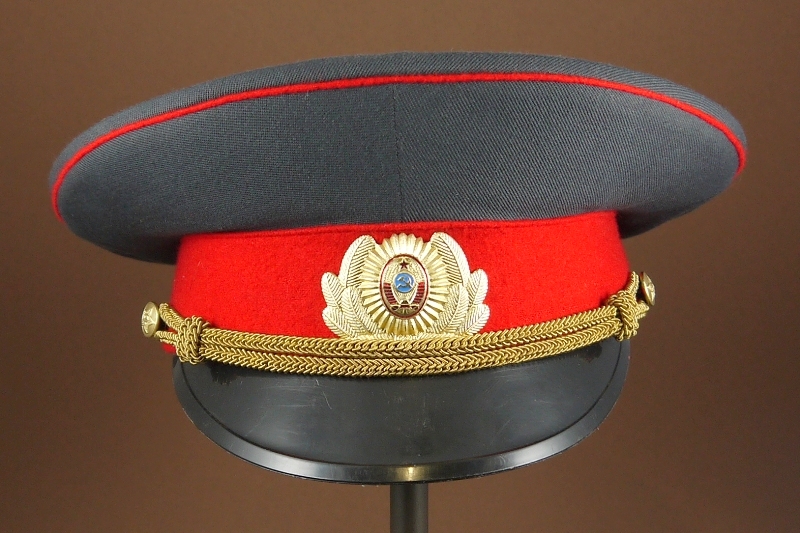
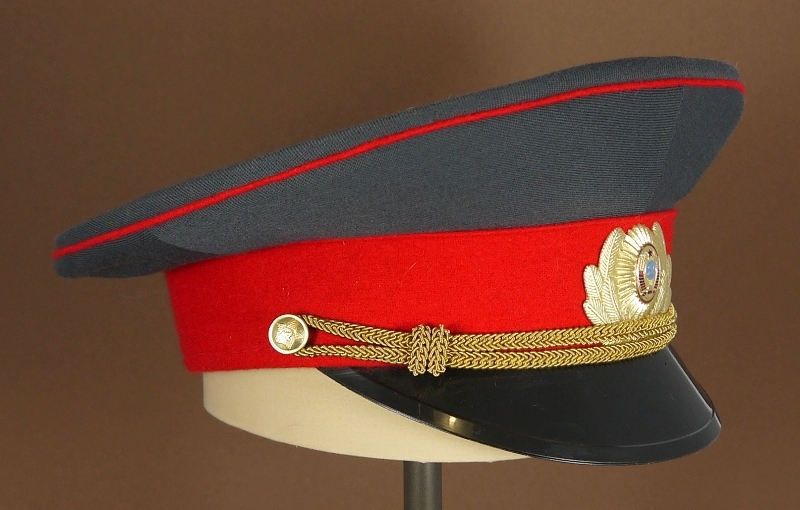 Militia
Militia
Officer/Militiaman Service/Parade
1977-1991
In 1977 the MVD changed the cap cockade from the 18-leaf emblem to the smaller 10-leaf emblem shown here. From that date, the basic gray Militia cap remained unchanged until the end of the Soviet Union.
The crown and band of this cap are identical to the one previously discussed but this 1988-dated version has the larger plastic visor standardized in the 1980s. The gold filigree cords and two-piece metal buttons remain
the same. The M77 Militia cockade is in one piece, made of anodized aluminum with painted colors on the Great Seal of the USSR in the center. This cockade may have been produced for a short time in two pieces - but
those pieces known to exist may also just be M58 Army wreaths with a fluted Police cockade attached. This is the most common of the police caps encountered.
Common
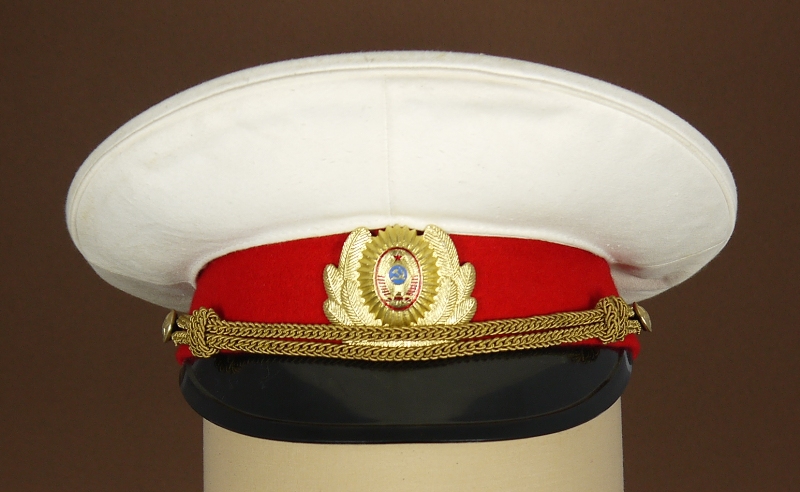
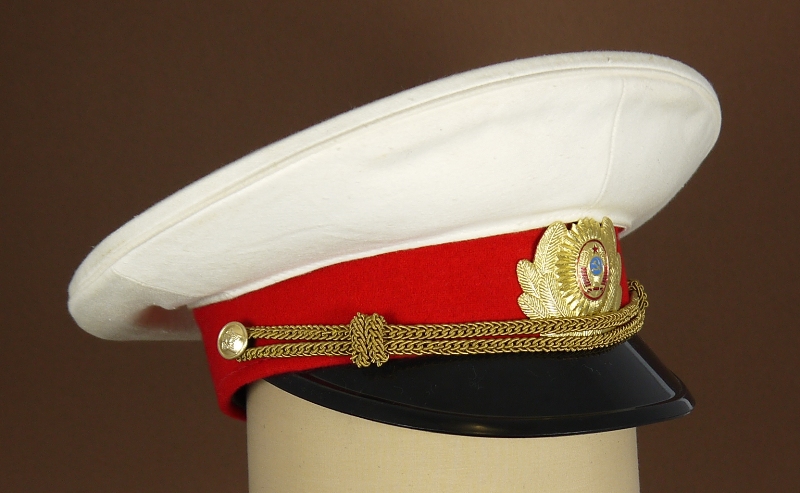 Militia
Militia
Officer/Militiaman Summer Service
1977-1991
The summer version of the above cap. White service caps had been used by the Soviet militia since its inception. These caps were most commonly part of "shirt-order" summer uniforms. This cap is no exception. It is of the style introduced after 1969 with a 1977 style militia cockade.
It has the larger M69 style crown and the later plastic visor. Like those used by the Navy, the white cover is removable and is piped in white. Gold cords are secured with army-style buttons. This cap remained in service past 1991 and is only slightly more difficult to find than the gray version.
Common-Available
| I've disassembled the above cap so you can see how those with removable covers are designed. As you can see in the pictures below, this type of cap is really a framework on which the cover is placed. The frame has a normal band but the crown is just padding held loosely together by a linen covering. This lighter, less-tightly woven structure resulted in a much cooler cap than if a winter cap was worn under a white cover. The lining is also lighter for summer wear - consisting of thin white cotton. Two additional white covers were normally issued with Naval caps to facilitate cleaning - I presume but cannot verify Militia caps were the same. |
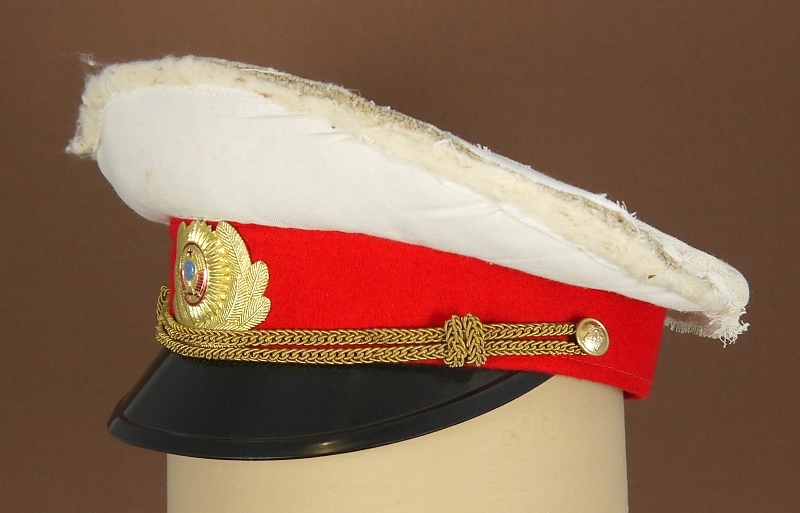
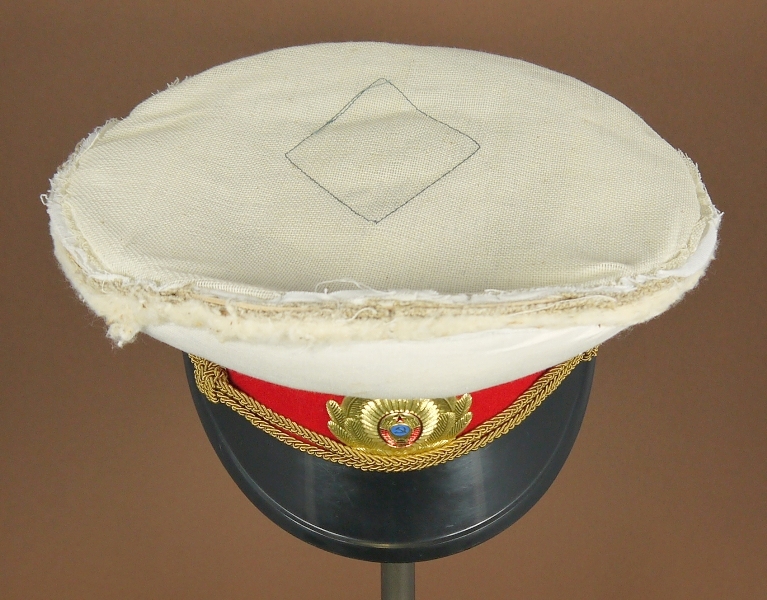
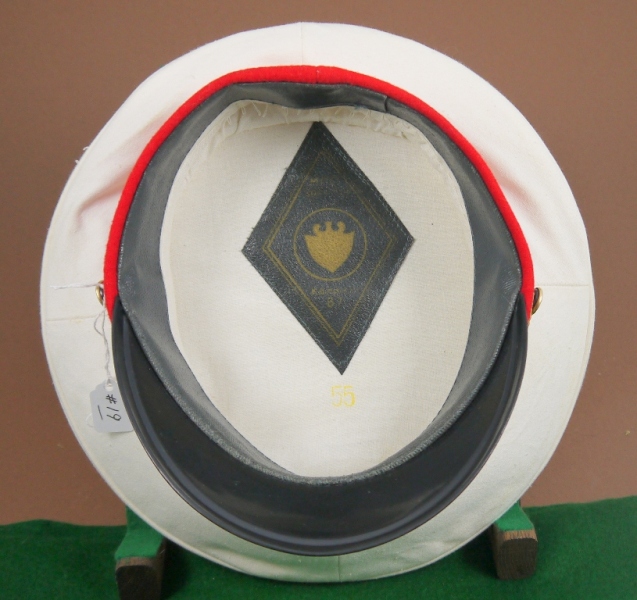
|
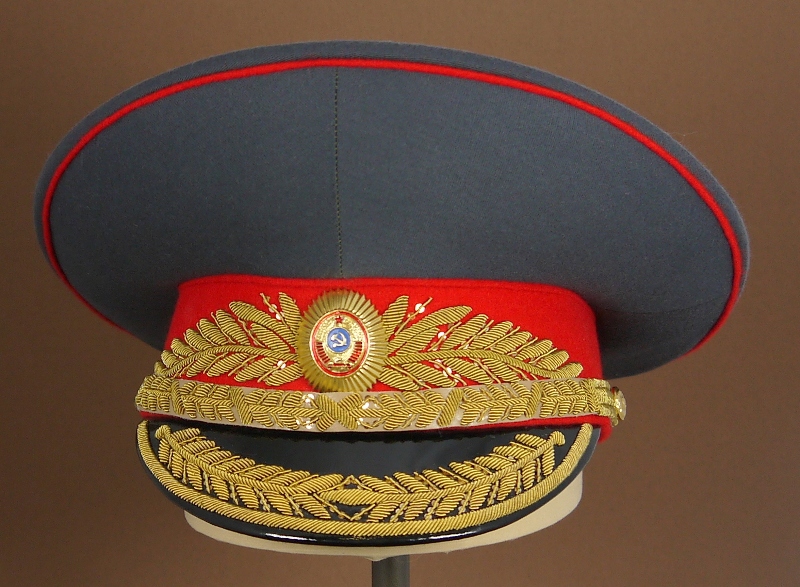
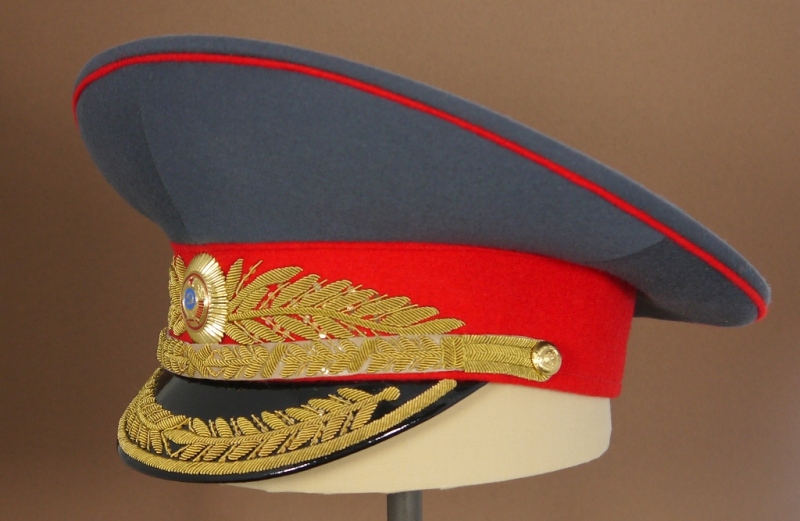 Militia
Militia
General Parade
1980s-1991
In 1973, Militia Commissioners were renamed Generals. This undated cap most likely dates from the late 1980s or early 1990s - because of its larger crown which, while unofficial, became a popular style at that time.
Both the crown circumference and the front height are 1/4 to 1/2 inch larger than on the M69. This was the most decorated of the gray Militia visor caps - with gilt wire embroidery on the band, visor and leather chin strap.
This pattern of stylized laurel leaf embroidery was identical to that used on M69 Army and MVD generals' parade caps. Only the central cockade was different - in this case the fluted Militia version.
The strap embroidery was also the same as for the Army. Standard generals' buttons with the Great Seal of the USSR hold the strap in place. The visor is black patent leather with black wool underneath.
Scarce
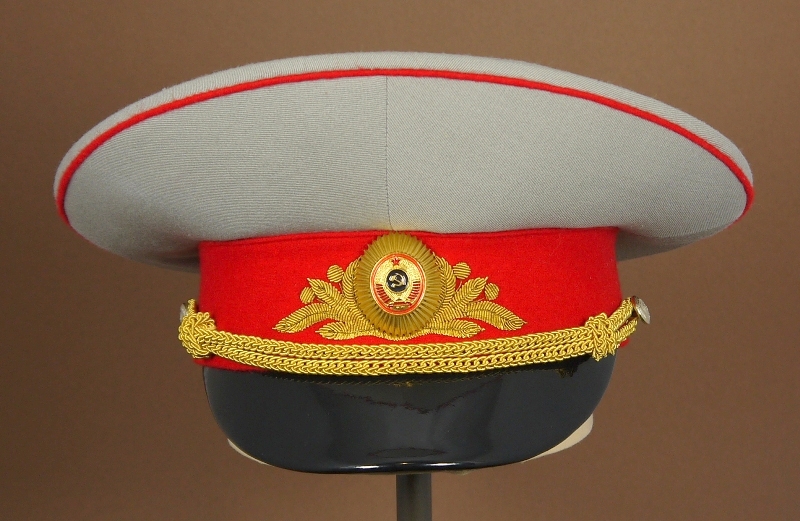
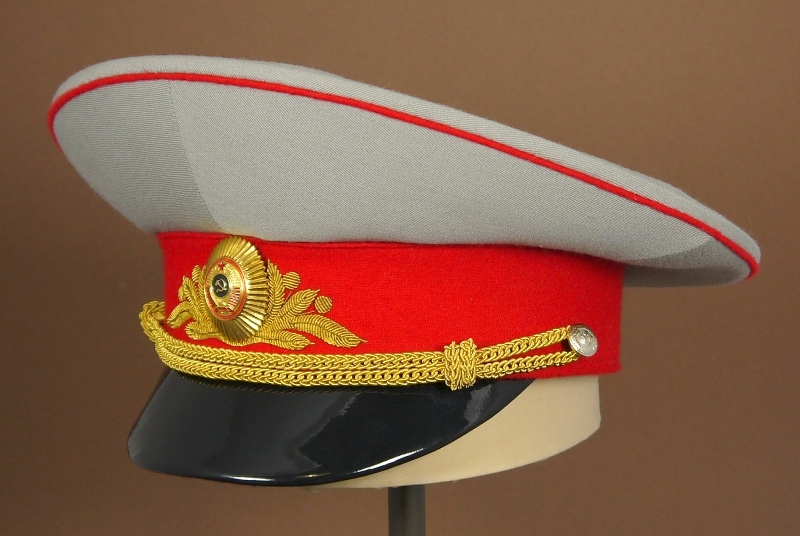 Militia
Militia
General Summer Service
1980-1991
In 1970 - one year after the 1969 regulations changed the blue Militia uniform to dark gray - Militia Generals were authorized a light gray jacket and visor cap for everyday wear in the Summer.
Until 1980, that "steel-colored" summer cap had no embroidery - just the plain fluted cockade. However, to bring Militia uniforms in line with those of the military, in 1980
the band embroidery shown here was authorized for generals' service caps. A regulation Militia cockade was pinned into the center of the wreath. A stamped metal version of this wreath was also produced but apparently not worn by many. You can see a picture of that emblem on my
Army 1969-1991 page.
Like the cap discussed above, this cap illustrates the enlarged crown of the late 1980s and 1990s. Golden filigree cords are held in place by gilt plastic generals' buttons and the visor is patent leather with black wool lining underneath. These patent leather visors came into service in the 1980s, replacing generals' fiberboard versions.
The interior is typical general officer - silk lining, leather sweatband with silk ribbon and leather maker's label.
Scarce
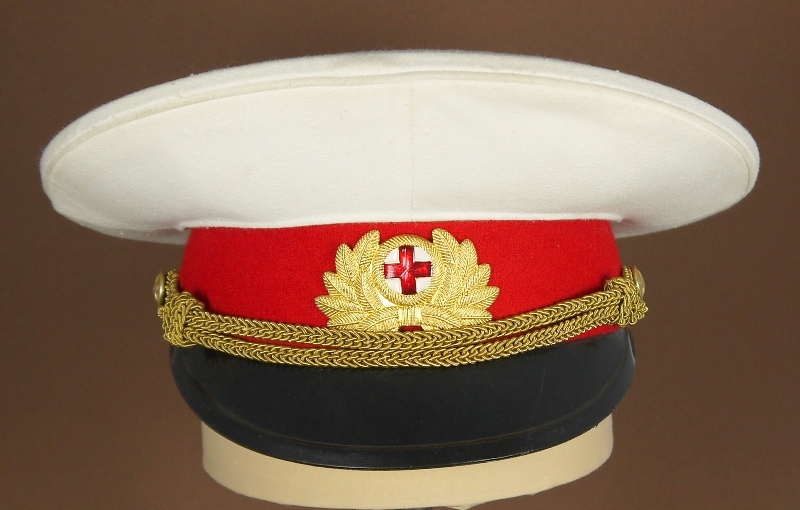
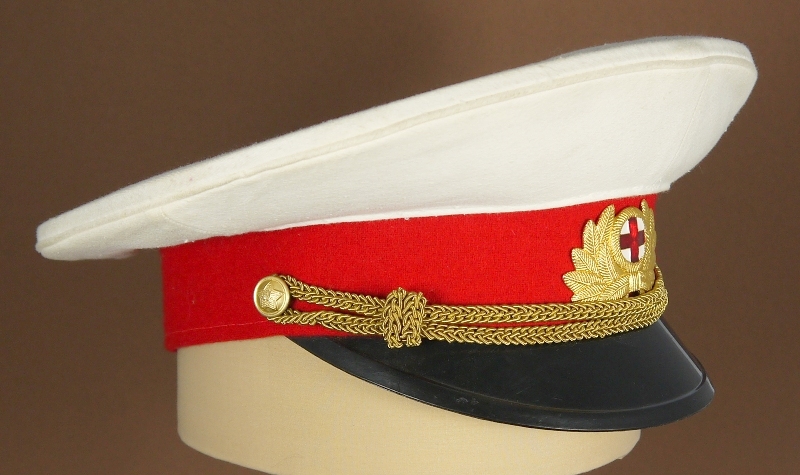 Militia
Militia
Drunk Treatment Facilities
1971-1974
This cap was authorized in 1971 for wear by militiamen assigned to drunk treatment facilities. Except for this emblem, the rest of the uniform worn by these personnel matched that of their other militia colleagues.
The cap itself is a standard summer version dated 1984, consisting of a padded framework over which a replaceable white cover was worn (gray caps were worn the rest of the year).
The band is red and gilt cords are held in place by regulation gilt-metal buttons with embossed star. The unique drunk treatment cockade was a one-piece emblem consisting of a red cold-enameled cross on a white background, surrounded by a gilt wreath.
This cap/badge combination was authorized for wear until 1974, when all personnel reverted to wearing standard militia emblems.
Scarce (with emblem)
| Summarized here is the evolution of the cockade and emblems (Russian parlance for the wreaths worn in conjunction with a cockade) used by the Soviet Militia. When first introduced to replace the blue star on caps in 1947, the Militia cockade came in two versions: one for officers with a fluted or corrugated edge and one for sergeants and privates with a pebbled edge. These were manufactured in tombac (a heavy brass and copper alloy) at first and in anodized aluminum after 1961. At that time all cockades were standardized on the officer model with fluted edges. In 1965, a new mixed silver/gilt emblem was authorized for parade wear. The gilt oval cockade remained on service caps. In 1969, a larger, all-gilt cockade was introduced for both everyday and parade wear by junior officers and the rank and file. Then finally, in 1977, an all-gilt version of the 1965-style emblem replaced the M69 cockade - for wear on service and parade caps. |


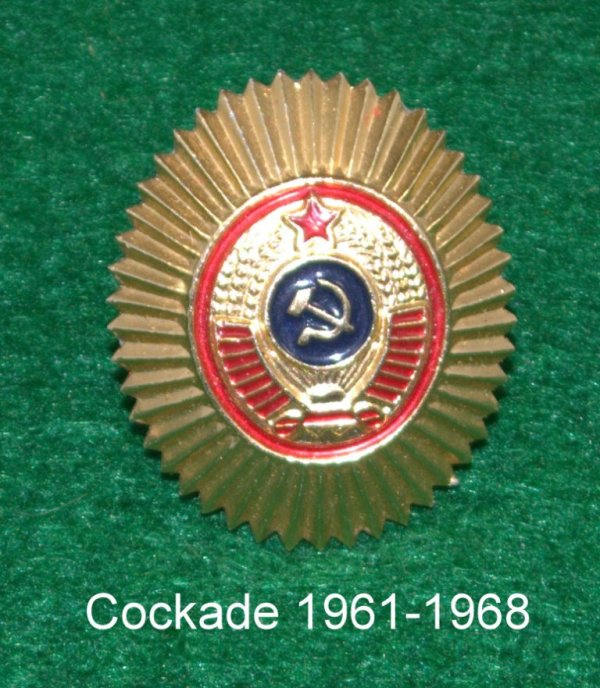
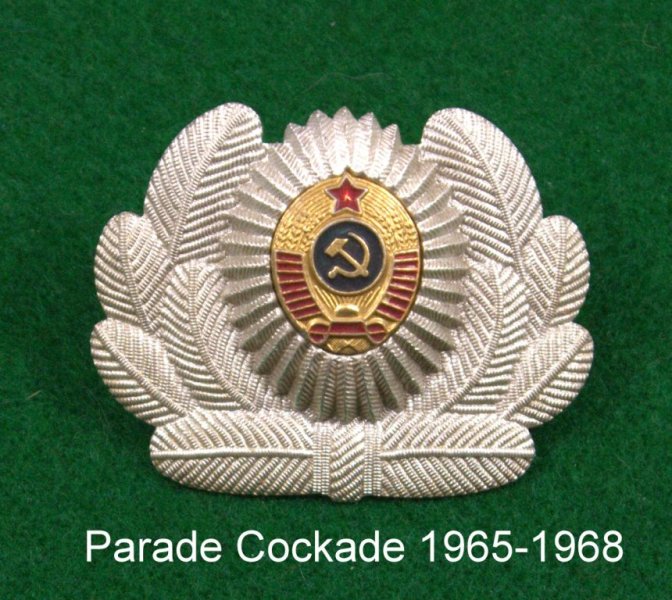
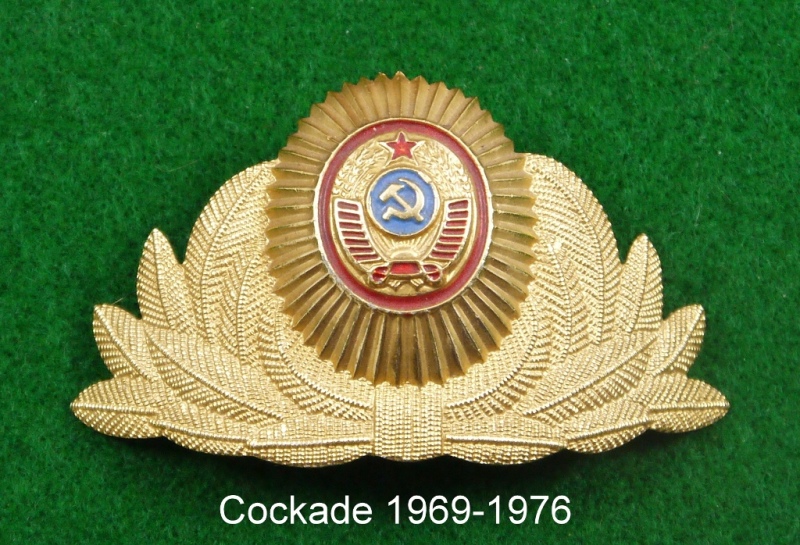
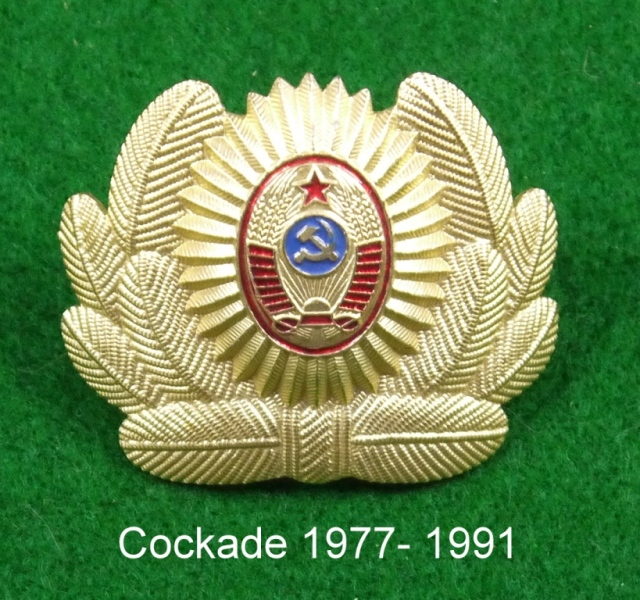
|
